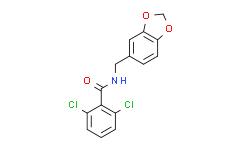| Cas No.: | 349438-38-6 |
| Chemical Name: | N-(1,3-Benzodioxol-5-ylmethyl)-2,6-dichlorobenzamide |
| Synonyms: | N-(1,3-Benzodioxol-5-ylmethyl)-2,6-dichlorobenzamide;Alda 1;Alda-1;Alda1;BXB;Oprea1_166989;MLS001206840;N-Benzo[1,3]dioxol-5-ylmethyl-2,6-dichloro-benzamide;Benzamide, N-(1,3-benzodioxol-5-ylmethyl)-2,6-dichloro-;N-(benzo[d][1,3]dioxol-5-ylmethyl)-2,6-dichlorobenzamide;HMS2847P05;BCP17146;STK417030;s5800;SMR000518092;AK547763;ST085712;B5508;Q27166749;N-[(2H-1,3-be |
| SMILES: | ClC1C([H])=C([H])C([H])=C(C=1C(N([H])C([H])([H])C1C([H])=C([H])C2=C(C=1[H])OC([H])([H])O2)=O)Cl |
| Formula: | C15H11Cl2NO3 |
| M.Wt: | 324.1587 |
| Sotrage: | 2 years -20°C Powder, 2 weeks 4°C in DMSO, 6 months -80°C in DMSO |
| Description: | Alda-1 is a potent ALDH2 agonist, which activates wild-type ALDH2 and restores near wild-type activity to ALDH2*2. |
| In Vivo: | Alda-1 treatment results in a significant decrease of 4-HNE-protein content in the plasma of apoE−/− mice. Alda-1 administration leads to a slight increase in gene expression related to neurogenesis (Nog), mitochondrial biogenesis (CYTB, ND1), and apoptosis (Bax, Gsk3b) in the Hp of apoE−/− mice. Alda-1 administration leads to 2 and 10 differentially expressed proteins in the FCx and Hp of apoE−/− mice, respectively[1]. Alda-1 (1.5 mg/kg, b.w., i.p.) administration significantly increases the climbing time, tends to reduce the immobility time and increases the swimming time of the prenatally stressed rats in the forced swim test. Moreover, treatment of prenatally stressed rats with Alda-1 significantly increases number of entries into the open arms of the maze and the time spent therein, as assessed by elevated plus-maze test[2]. Alda-1 (8.5 mg/kg, i.p.) with glucose significantly lowers 4-HNE and FJB-positive cells in the cerebral cortex of Alda-1-treated rats than in DMSO-treated rats 24 h after glucose administration[3]. Alda-1 (10 mg/kg per day) treatment prevents aldehydic overload, mitochondrial dysfunction and improves ventricular function in post-MI cardiomyopathy rats[4]. |

 DC Chemicals' products qualify for U.S. tariff exemptions. We guarantee no price increases due to customs duties and maintain stable supply, continuing to deliver reliable research solutions to our American clients.
DC Chemicals' products qualify for U.S. tariff exemptions. We guarantee no price increases due to customs duties and maintain stable supply, continuing to deliver reliable research solutions to our American clients.





















